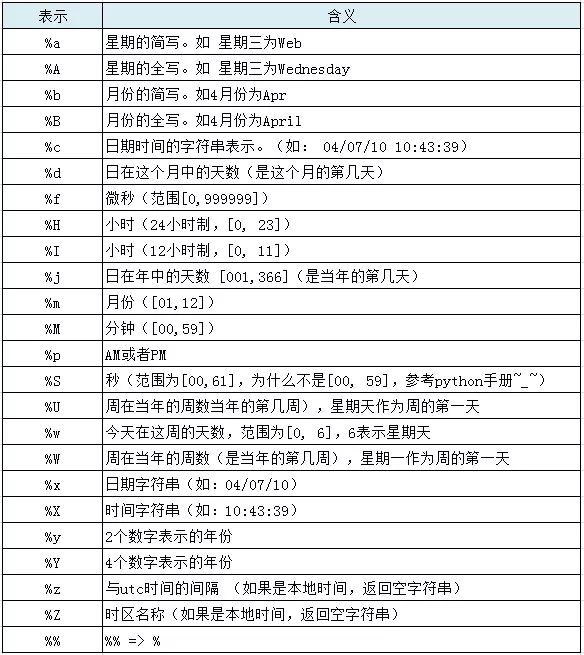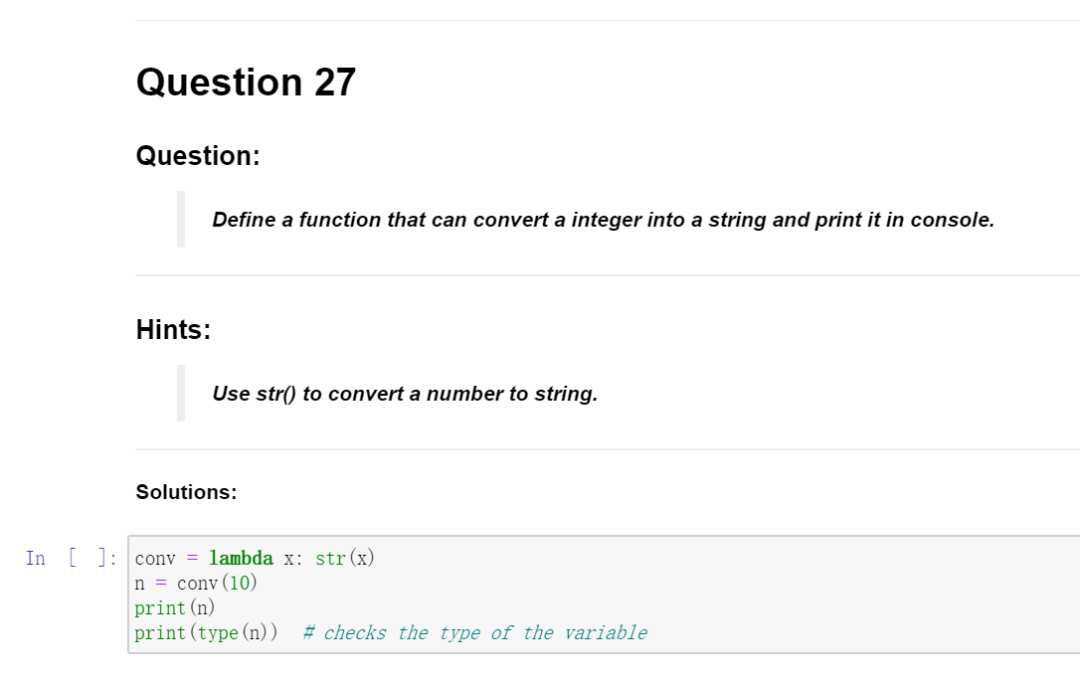【Python基础】快速入门Python(讲解、习题)
0.导语
Python是一种跨平台的计算机程序设计语言。是一种面向对象的动态类型语言,最初被设计用于编写自动化脚本(shell),随着版本的不断更新和语言新功能的添加,越来越多被用于独立的、大型项目的开发。
 在此之前,我已经写了以下几篇AI基础的快速入门,本篇文章讲解python语言的基础部分,也是后续内容的基础。
在此之前,我已经写了以下几篇AI基础的快速入门,本篇文章讲解python语言的基础部分,也是后续内容的基础。
本文代码可以在github下载:
https://github.com/fengdu78/Data-Science-Notes/tree/master/1.python-basic
文件名:Python_Basic.ipynb
习题代码:
https://github.com/fengdu78/Data-Science-Notes/tree/master/1.python-basic/Python-100
1 Python数据类型
1.1 字符串
在Python中用引号引起来的字符集称之为字符串,比如:'hello'、"my Python"、"2+3"等都是字符串 Python中字符串中使用的引号可以是单引号、双引号跟三引号
print ('hello world!')
hello world!
c = 'It is a "dog"!'
print (c)
It is a "dog"!
c1= "It's a dog!"
print (c1)
It's a dog!
c2 = """hello
world
!"""
print (c2)
hello
world
!
转义字符''
转义字符\可以转义很多字符,比如\n表示换行,\t表示制表符,字符\本身也要转义,所以\ \表示的字符就是\
print ('It\'s a dog!')
print ("hello world!\nhello Python!")
print ('\\\t\\')
It's a dog!
hello world!
hello Python!
\ \
原样输出引号内字符串可以使用在引号前加r
print (r'\\\t\\')
\\\t\\
子字符串及运算
s = 'Python'
print( 'Py'in s)
print( 'py'in s)
True
False
取子字符串有两种方法,使用[]索引或者切片运算法[:],这两个方法使用面非常广
print (s[2])
t
print (s[1:4])
yth
字符串连接与格式化输出
word1 = '"hello"'
word2 = '"world"'
sentence = word1.strip('"') + ' ' + word2.strip('"') + '!'
print( 'The first word is %s, and the second word is %s' %(word1, word2))
print (sentence)
The first word is "hello", and the second word is "world"
hello world!
1.2 整数与浮点数
整数
Python可以处理任意大小的整数,当然包括负整数,在程序中的表示方法和数学上的写法一模一样
i = 7
print (i)
7
7 + 3
10
7 - 3
4
7 * 3
21
7 ** 3
343
7 / 3#Python3之后,整数除法和浮点数除法已经没有差异
2.3333333333333335
7 % 3
1
7//3
2浮点数
7.0 / 3
2.3333333333333335
3.14 * 10 ** 2
314.0
其它表示方法
0b1111
15
0xff
255
1.2e-5
1.2e-05
更多运算
import math
print (math.log(math.e)) # 更多运算可查阅文档
1.0
1.3 布尔值
True
True
False
False
TrueandFalse
False
TrueorFalse
True
notTrue
False
True + False
1
18 >= 6 * 3or'py'in'Python'
True
18 >= 6 * 3and'py'in'Python'
False
18 >= 6 * 3and'Py'in'Python'
True
1.4 日期时间
import time
now = time.strptime('2016-07-20', '%Y-%m-%d')
print (now)
time.struct_time(tm_year=2016, tm_mon=7, tm_mday=20, tm_hour=0, tm_min=0, tm_sec=0, tm_wday=2, tm_yday=202, tm_isdst=-1)
time.strftime('%Y-%m-%d', now)
'2016-07-20'
import datetime
someDay = datetime.date(1999,2,10)
anotherDay = datetime.date(1999,2,15)
deltaDay = anotherDay - someDay
deltaDay.days
5
还有其他一些datetime格式
查看变量类型
type(None)
NoneType
type(1.0)
float
type(True)
bool
s="NoneType"
type(s)
str
类型转换
str(10086)
'10086'
?float()
float(10086)
10086.0
int('10086')
10086
complex(10086)
(10086+0j)
2 Python数据结构
列表(list)、元组(tuple)、集合(set)、字典(dict)
2.1 列表(list)
用来存储一连串元素的容器,列表用[]来表示,其中元素的类型可不相同。
mylist= [0, 1, 2, 3, 4, 5]
print (mylist)
[0, 1, 2, 3, 4, 5]
列表索引和切片
# 索引从0开始,含左不含右
print ('[4]=', mylist[4])
print ('[-4]=', mylist[-4])
print ('[0:4]=', mylist[0:4])
print ('[:4]=', mylist[:4])#dddd
print( '[4:]=', mylist[4:])
print ('[0:4:2]=', mylist[0:4:2])
print ('[-5:-1:]=', mylist[-5:-1:])
print ('[-2::-1]=', mylist[-2::-1])
[4]= 4
[-4]= 2
[0:4]= [0, 1, 2, 3]
[:4]= [0, 1, 2, 3]
[4:]= [4, 5]
[0:4:2]= [0, 2]
[-5:-1:]= [1, 2, 3, 4]
[-2::-1]= [4, 3, 2, 1, 0]
修改列表
mylist[3] = "小月"
print (mylist[3])
mylist[5]="小楠"
print (mylist[5])
mylist[5]=19978
print (mylist[5])
小月
小楠
19978
print (mylist)
[0, 1, 2, '小月', 4, 19978]
插入元素
mylist.append('han') # 添加到尾部
mylist.extend(['long', 'wan'])
print (mylist)
[0, 1, 2, '小月', 4, 19978, 'han', 'long', 'wan']
scores = [90, 80, 75, 66]
mylist.insert(1, scores) # 添加到指定位置
mylist
[0, [90, 80, 75, 66], 1, 2, '小月', 4, 19978, 'han', 'long', 'wan']
a=[]
删除元素
print (mylist.pop(1)) # 该函数返回被弹出的元素,不传入参数则删除最后一个元素
print (mylist)
[90, 80, 75, 66]
[0, 1, 2, '小月', 4, 19978, 'han', 'long', 'wan']
判断元素是否在列表中等
print( 'wan'in mylist)
print ('han'notin mylist)
True
False
mylist.count('wan')
1
mylist.index('wan')
8
range函数生成整数列表
print (range(10))
print (range(-5, 5))
print (range(-10, 10, 2))
print (range(16, 10, -1))
range(0, 10)
range(-5, 5)
range(-10, 10, 2)
range(16, 10, -1)
2.2 元组(tuple)
元组类似列表,元组里面的元素也是进行索引计算。列表里面的元素的值可以修改,而元组里面的元素的值不能修改,只能读取。元组的符号是()。
studentsTuple = ("ming", "jun", "qiang", "wu", scores)
studentsTuple
('ming', 'jun', 'qiang', 'wu', [90, 80, 75, 66])
try:
studentsTuple[1] = 'fu'
except TypeError:
print ('TypeError')
TypeError
scores[1]= 100
studentsTuple
('ming', 'jun', 'qiang', 'wu', [90, 100, 75, 66])
'ming'in studentsTuple
True
studentsTuple[0:4]
('ming', 'jun', 'qiang', 'wu')
studentsTuple.count('ming')
1
studentsTuple.index('jun')
1
len(studentsTuple)
5
2.3 集合(set)
Python中集合主要有两个功能,一个功能是进行集合操作,另一个功能是消除重复元素。集合的格式是:set(),其中()内可以是列表、字典或字符串,因为字符串是以列表的形式存储的
studentsSet = set(mylist)
print (studentsSet)
{0, 1, 2, 'han', 4, '小月', 19978, 'wan', 'long'}
studentsSet.add('xu')
print (studentsSet)
{0, 1, 2, 'han', 4, '小月', 19978, 'wan', 'long', 'xu'}
studentsSet.remove('xu')
print (studentsSet)
{0, 1, 2, 'han', 4, '小月', 19978, 'wan', 'long'}
mylist.sort()#会出错
---------------------------------------------------------------------------
TypeError Traceback (most recent call last)
in ()
----> 1 mylist.sort()
TypeError: '<' not supported between instances of 'str' and 'int'
a = set("abcnmaaaaggsng")
print ('a=', a)
a= {'b', 'a', 'm', 'c', 'g', 's', 'n'}
b = set("cdfm")
print ('b=', b)
b= {'m', 'd', 'c', 'f'}
#交集
x = a & b
print( 'x=', x)
x= {'m', 'c'}
#并集
y = a | b
print ('y=', y)
#差集
z = a - b
print( 'z=', z)
#去除重复元素
new = set(a)
print( z)
y= {'b', 'a', 'f', 'd', 'm', 'c', 'g', 's', 'n'}
z= {'b', 'a', 'g', 's', 'n'}
{'b', 'a', 'g', 's', 'n'}
2.4字典(dict)
Python中的字典dict也叫做关联数组,用大括号{}括起来,在其他语言中也称为map,使用键-值(key-value)存储,具有极快的查找速度,其中key不能重复。
k = {"name":"weiwei", "home":"guilin"}
print (k["home"])
guilin
print( k.keys())
print( k.values())
dict_keys(['name', 'home'])
dict_values(['weiwei', 'guilin'])
添加、修改字典里面的项目
k["like"] = "music"
k['name'] = 'guangzhou'
print (k)
{'name': 'guangzhou', 'home': 'guilin', 'like': 'music'}
k.get('edu', -1) # 通过dict提供的get方法,如果key不存在,可以返回None,或者自己指定的value
-1
删除key-value元素
k.pop('like')
print (k)
{'name': 'guangzhou', 'home': 'guilin'}
2.5 列表、元组、集合、字典的互相转换
type(mylist)
list
tuple(mylist)
(0, 1, 2, '小月', 4, 19978, 'han', 'long', 'wan')
list(k)
['name', 'home']
zl = zip(('A', 'B', 'C'), [1, 2, 3, 4]) # zip可以将列表、元组、集合、字典‘缝合’起来
print (zl)
print (dict(zl))
{'A': 1, 'B': 2, 'C': 3}
3 Python控制流
在Python中通常的情况下程序的执行是从上往下执行的,而某些时候我们为了改变程序的执行顺序,使用控制流语句控制程序执行方式。Python中有三种控制流类型:顺序结构、分支结构、循环结构。
另外,Python可以使用分号";"分隔语句,但一般是使用换行来分隔;语句块不用大括号"{}",而使用缩进(可以使用四个空格)来表示
3.1 顺序结构
s = '7'
num = int(s) # 一般不使用这种分隔方式
num -= 1# num = num - 1
num *= 6# num = num * 6
print (num)
36
3.2 分支结构:Python中if语句是用来判断选择执行哪个语句块的
if
执行语句块
elif
执行语句块
else: # 都不满足
执行语句块
#elif子句可以有多条,elif和else部分可省略
salary = 1000
if salary > 10000:
print ("Wow!!!!!!!")
elif salary > 5000:
print ("That's OK.")
elif salary > 3000:
print ("5555555555")
else:
print ("..........")
..........
3.3 循环结构
while 循环
while
循环执行语句块
else: # 不满足条件
执行语句块
#else部分可以省略
a = 1
while a < 10:
if a <= 5:
print (a)
else:
print ("Hello")
a = a + 1
else:
print ("Done")
1
2
3
4
5
Hello
Hello
Hello
Hello
Done
for 循环 for (条件变量) in (集合):
执行语句块
“集合”并不单指set,而是“形似”集合的列表、元组、字典、数组都可以进行循环
条件变量可以有多个
heights = {'Yao':226, 'Sharq':216, 'AI':183}
for i in heights:
print (i, heights[i])
Yao 226
Sharq 216
AI 183
for key, value in heights.items():
print(key, value)
Yao 226
Sharq 216
AI 183
total = 0
for i in range(1, 101):
total += i#total=total+i
print (total)
5050
3.4 break、continue和pass
break:跳出循环
continue:跳出当前循环,继续下一次循环
pass:占位符,什么也不做
for i in range(1, 5):
if i == 3:
break
print (i)
1
2
for i in range(1, 5):
if i == 3:
continue
print (i)
1
2
4
for i in range(1, 5):
if i == 3:
pass
print (i)
1
2
3
4
3.5 列表生成式
三种形式
[<表达式> for (条件变量) in (集合)] [<表达式> for (条件变量) in (集合) if <'True or False'表达式>] [<表达式> if <'True or False'表达式> else <表达式> for (条件变量) in (集合) ]
fruits = ['"Apple', 'Watermelon', '"Banana"']
[x.strip('"') for x in fruits]
['Apple', 'Watermelon', 'Banana']
# 另一种写法
test_list=[]
for x in fruits:
x=x.strip('"')
test_list.append(x)
test_list
['Apple', 'Watermelon', 'Banana']
[x ** 2for x in range(21) if x%2]
[1, 9, 25, 49, 81, 121, 169, 225, 289, 361]
# 另一种写法
test_list=[]
for x in range(21):
if x%2:
x=x**2
test_list.append(x)
test_list
[1, 9, 25, 49, 81, 121, 169, 225, 289, 361]
[m + n for m in'ABC'for n in'XYZ']
['AX', 'AY', 'AZ', 'BX', 'BY', 'BZ', 'CX', 'CY', 'CZ']
# 另一种写法
test_list=[]
for m in'ABC':
for n in'XYZ':
x=m+n
test_list.append(x)
test_list
['AX', 'AY', 'AZ', 'BX', 'BY', 'BZ', 'CX', 'CY', 'CZ']
d = {'x': 'A', 'y': 'B', 'z': 'C' }
[k + '=' + v for k, v in d.items()]
['x=A', 'y=B', 'z=C']
# 另一种写法
test_list=[]
for k, v in d.items():
x=k + '=' + v
test_list.append(x)
test_list
['x=A', 'y=B', 'z=C']
4 Python函数
函数是用来封装特定功能的实体,可对不同类型和结构的数据进行操作,达到预定目标。
4.1 调用函数
Python内置了很多有用的函数,我们可以直接调用,进行数据分析时多数情况下是通过调用定义好的函数来操作数据的
str1 = "as"
int1 = -9
print (len(str1))
print (abs(int1))
2
9
fruits = ['Apple', 'Banana', 'Melon']
fruits.append('Grape')
print (fruits)
['Apple', 'Banana', 'Melon', 'Grape']
4.2 定义函数
当系统自带函数不足以完成指定的功能时,需要用户自定义函数来完成。def 函数名():函数内容 函数内容
def my_abs(x):
if x >= 0:
return x
else:
return -x
my_abs(-9)
9
可以没有return
def filter_fruit(someList, d):
for i in someList:
if i == d:
someList.remove(i)
else:
pass
print (filter_fruit(fruits, 'Melon'))
print (fruits)
None
['Apple', 'Banana', 'Grape']
多个返回值的情况
def test(i, j):
k = i * j
return i, j, k
a , b , c = test(4, 5)
print (a, b , c)
type(test(4, 5))
4 5 20
tuple
4.3 高阶函数
把另一个函数作为参数传入一个函数,这样的函数称为高阶函数
函数本身也可以赋值给变量,函数与其它对象具有同等地位
myFunction = abs
myFunction(-9)
9
参数传入函数
def add(x, y, f):
return f(x) + f(y)
add(7, -5, myFunction)
12
常用高阶函数
map/reduce: map将传入的函数依次作用到序列的每个元素,并把结果作为新的list返回;reduce把一个函数作用在一个序列[x1, x2, x3...]上,这个函数必须接收两个参数,reduce把结果继续和序列的下一个元素做累积计算
myList = [-1, 2, -3, 4, -5, 6, 7]
map(abs, myList)
from functools import reduce
def powerAdd(a, b):
return pow(a, 2) + pow(b, 2)
reduce(powerAdd, myList) # 是否是计算平方和?
3560020598205630145296938
filter:filter()把传入的函数依次作用于每个元素,然后根据返回值是True还是False决定保留还是丢弃该元素
def is_odd(x):
return x % 3# 0被判断为False,其它被判断为True
filter(is_odd, myList)
sorted: 实现对序列排序,默认情况下对于两个元素x和y,如果认为x < y,则返回-1,如果认为x == y,则返回0,如果认为x > y,则返回1
默认排序:数字大小或字母序(针对字符串)
sorted(myList)
[-5, -3, -1, 2, 4, 6, 7]
*练习:自定义一个排序规则函数,可将列表中字符串忽略大小写地,按字母序排列,列表为['Apple', 'orange', 'Peach', 'banana']。提示:字母转换为大写的方法为some_str.upper(),转换为小写使用some_str.lower()
返回函数: 高阶函数除了可以接受函数作为参数外,还可以把函数作为结果值返回
def powAdd(x, y):
def power(n):
return pow(x, n) + pow(y, n)
return power
myF = powAdd(3, 4)
myF
.power>
myF(2)
25
匿名函数:高阶函数传入函数时,不需要显式地定义函数,直接传入匿名函数更方便
f = lambda x: x * x
f(4)
16
等同于:
def f(x):
return x * x
map(lambda x: x * x, myList)
匿名函数可以传入多个参数
reduce(lambda x, y: x + y, map(lambda x: x * x, myList))
140
返回函数可以是匿名函数
def powAdd1(x, y):
returnlambda n: pow(x, n) + pow(y, n)
lamb = powAdd1(3, 4)
lamb(2)
25
其它
标识符第一个字符只能是字母或下划线,第一个字符不能出现数字或其他字符;标识符除第一个字符外,其他部分可以是字母或者下划线或者数字,标识符大小写敏感,比如name跟Name是不同的标识符。 Python规范:
类标识符每个字符第一个字母大写; 对象\变量标识符的第一个字母小写,其余首字母大写,或使用下划线'_' 连接; 函数命名同普通对象。
关键字
关键字是指系统中自带的具备特定含义的标识符
# 查看一下关键字有哪些,避免关键字做自定义标识符
import keyword
print (keyword.kwlist)
['False', 'None', 'True', 'and', 'as', 'assert', 'break', 'class', 'continue', 'def', 'del', 'elif', 'else', 'except', 'finally', 'for', 'from', 'global', 'if', 'import', 'in', 'is', 'lambda', 'nonlocal', 'not', 'or', 'pass', 'raise', 'return', 'try', 'while', 'with', 'yield']
注释
Python中的注释一般用#进行注释
帮助
Python中的注释一般用?查看帮助
练习题
这个仓库一共有24个Jupyter notebook文件(每天一个),每个文件有3-5个练习,一共104题。
如果您是python的初学者,那么这100多个练习可以帮助您轻松地使用Python。
仓库给定的问题非常简单和容易理解。初学者每天可以尝试3-5个问题,需要一点时间来解决,但肯定会学到一些新的东西(不管你有多懒),经过一个月的常规练习,把练习做完看懂,只要能独立解决100多个问题,基本上Python就入门了。
来源:
https://github.com/darkprinx/100-plus-Python-programming-exercises-extended
仓库内容
这个仓库一共有24个Jupyter notebook文件(每天一个),每个文件有3-5个练习,一共104题。
问题模板格式
提问 提示 解答
在这个仓库是用Python3 语言。作者修正一些随机错误和变量命名,符合PEP8规范,仓库分为Jupyter notebook格式(文件夹名称:notebooks)和Markdown格式(文件夹名称:Status)两个文件夹,两者内容一致。
内容截图

内容截图
习题下载
本文代码可以在github下载:
https://github.com/fengdu78/Data-Science-Notes/tree/master/1.python-basic
文件名:Python_Basic.ipynb
习题代码:
https://github.com/fengdu78/Data-Science-Notes/tree/master/1.python-basic/Python-100
